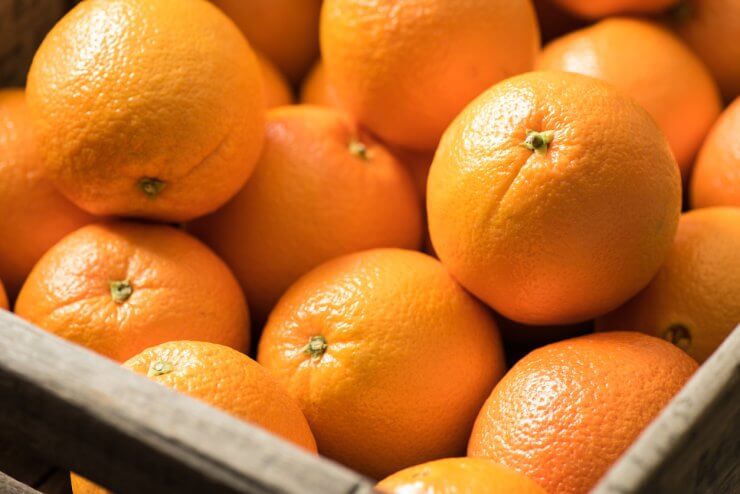
Oranges growing on orange tree in garden

Oranges growing on orange tree in garden
Evergreen trees are beautiful; they add color to the landscape all year long, and are a welcome sight in regions where deciduous trees lose their leaves in autumn as winter approaches. Of course, when someone hears the term “evergreen,” they start to think of pine, spruce, fir, hemlock, yew, redwood, and more.
Citrus trees are evergreens, too, but are more at home in Mediterranean climates than the climates of, say, the Upper Midwest. They keep their leaves year-round. And even better—they supply us with delicious fruit, sometimes more than once in a season! Throughout the world more people grow orange trees than any other tree. That’s no surprise: they’re lovely trees, they produce delicious fruit, and they’re pretty easy to get along with.
Even if you don’t live in a Mediterranean climate—for instance, if you do your best gardening in the Upper Midwest—don’t let the climate deter you from growing your own orange tree. There are cultivars completely suited to growing in containers, and they can spend the cold months of winter inside with you, sharing their luscious fragrance.
There are no location limits for growing orange trees. You just need soil, sunshine, and enough space for your orange to branch out.
If you are in USDA Plant Hardiness Zones 8 to 11, you can grow your oranges in the ground year-round. After you harvest your last orange for the season, you might give your tree a little trim, then let it kick back until flowering time rolls around. If you’re in zones 4 to 11, you can grow your orange tree in a container, and take it inside before the first hard frost. Make sure you have a sunny window (and a high enough ceiling) to keep your tree comfortable through the cold months.
Oranges do best in well-draining, rich soil with a good amount of organic matter. If orange trees sit in water, they are at risk for developing root rot. If you’ve found an ideal sunny spot for your new orange tree, make sure the water drains away from the spot. If it starts to pool, hill up the soil to give your new tree a little boost.
The general pH range for oranges is 5.5 to 6.5. Before you go planning where to plant your oranges, do get your soil tested. It’s an easy process, and you can save yourself a lot of frustration and disappointment by preparing the soil to welcome your new tree.
Orange trees have fairly shallow roots, but they like a good long drink of water about once a week, somewhere in the inch to inch-and-a-half range. Always check to make sure you’re not killing your orange tree with kindness. Less water is better than too much.
A Brief History of Oranges

Navel oranges in wooden crate stock
The common orange tree, Citrus sinensis, is not a naturally occurring species. Most scientists agree that the orange tree is an intentional cross of a hybrid mandarin orange (Citrus reticulata) and a hybrid pomelo (Citrus maxima). Now, oranges appear to have first been domesticated in China, so this could be where they got their start. But they spread quickly to other parts of subtropical Asia, then on to the Mediterranean, and eventually to the Americas.
Spanish missionaries brought orange trees to California in the early 1800s, and the tree flourished in the bright, warm sunshine. Los Angeles was once home to a small 2-acre orchard where the proprietor sold his precious crop to gold prospectors up north who were willing to pay a premium price for a fruit that would help prevent scurvy and keep them at the top of their prospecting game.
The citrus industry took off in the 1870s with the arrival of the Washington navel orange. This variety was sweeter and easier to peel than the mission variety. When the Transcontinental Railroad reached the West Coast, orange growers took advantage of the opportunity to ply their trade back east. Refrigerated rail cars sweetened their prospects.
Today, sweet oranges top the list of popular citrus. Worldwide, three quarters of commercial oranges are made into juice; the other quarter goes to market as fresh fruit. Florida, California, and Texas lead the U.S. in orange production.
California celebrates its role in the citrus industry with the California Citrus State Historic Park. Take a walk back in time to when “Citrus was King” during the Gold Rush. Learn how two tiny orange trees forever changed the landscape of the orange industry. Tour an orange grove, see how oranges are sorted and packed, or visit some of the exhibits.
Communities in California, Florida, Arizona, and Texas celebrate their orange industry at different times of year. In Italy and France, they hold festivals in a big way, with activities ranging from food fights to fabulous floats.
Did you know about the history of oranges? Are you excited to try growing them? Let us know what you think.



